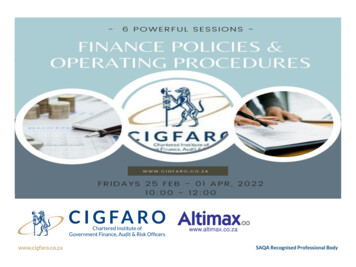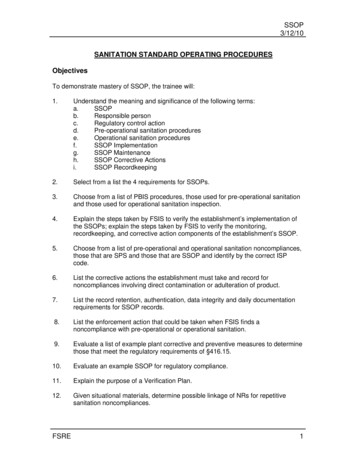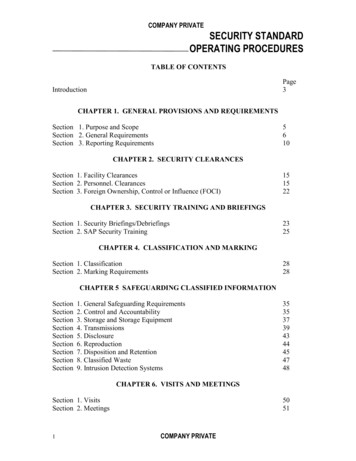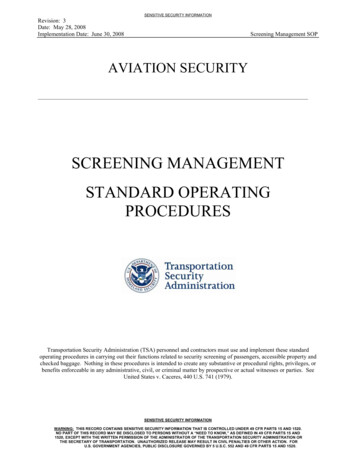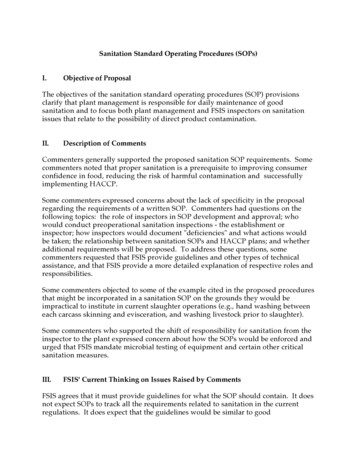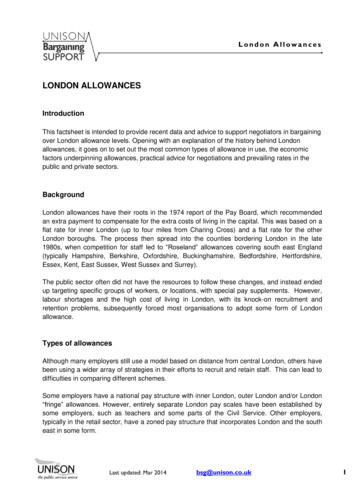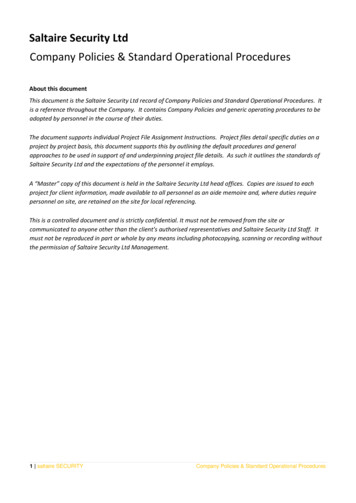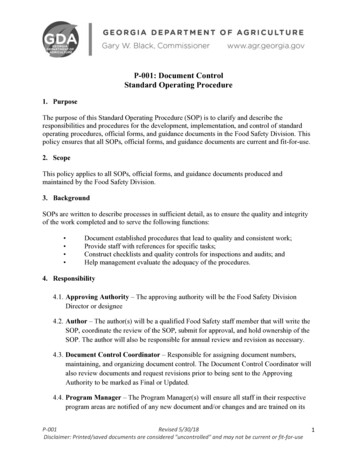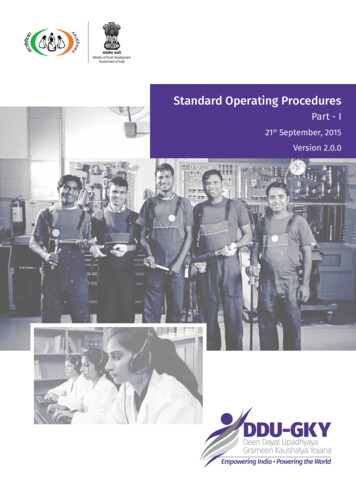
Transcription
Standard Operating ProceduresPart - I21st September, 2015Version 2.0.0
“Transforming rural youthinto an economicallyindependent and globallyrelevant workforce”
PREFACEThe manuals on Standard Operating Procedures (SOPs) are intended to be used as a supplement to the DeenDayal Upadhyaya Grameen Kaushal Yojana (DDU-GKY) Guidelines. The primary purpose of the manuals is to detailthe minimum common protocols to be followed by stakeholders in implementation of placement linked skilldevelopment projects under DDU-GKY. Stakeholders here are the registered Project Implementing Agencies, StateRural Livelihoods Mission /State Nodal Skill Mission, Central Technical Support Agencies, any Central or StateGovernment functionary/department involved in project management or monitoring of DDU-GKY projects, includingRoshni projects, in the country.It is assumed that readers of SOPs are aware of National Policy for Skill Development and Entrepreneurship,2015, DDU-GKY Guidelines and have some familiarity with elementary concepts of skill development, training andplacement in jobs.DDU-GKY is implemented in a PPP mode by Project Implementing Agencies (PIAs) selected through a process ofappraisal of their capacities and capabilities. This model has been tried and tested in more than 190 special projectsfor placement linked skill development under Swarnjayanti Gram Swarozgar Yojana (which was subsequentlyrenamed as National Rural Livelihood Mission) during the years 2004 till 2013.One of the important learning from the implementation of SGSY/NRLM special projects, inter-alia, was thatinadequate or lack of clear operational protocols translated into deliverables without any standards. Projectimplementation became a factor of a process of negotiated agreements in each training center between the ProjectImplementing Agency and the officer from Monitoring Agencies (State as well as Central). Such agreements were notformal in nature and were often transient. They were subject to the interpretations of monitoring officer checkingthe Training Center. This led to variations in appraisal and monitoring process across training centers.While it can be said that variations in projects allowed for flexibility in implementation of a project on the basis oflocal requirement, Quality & Assurance in training infrastructure, course content, training delivery, trainers, andquality of skills and attitude imparted to candidates was negatively impacted. It also led to discretion and delay infund release to the PIAs, mostly as a result of failure in negotiated agreements between the stakeholders that werepoorly documented. This caused great inconvenience to the Project Implementing Agencies, whose cash-flow for aproject was most often disrupted. But greater loss lay for the rural poor undertaking the course, since the stalled orpoor quality training projects impacted them the most by denying them opportunity to come out of poverty.DDU-GKY follows a three-tier level of concurrent monitoring, i.e. Monitoring by an internal Quality Team (Q-Team) ofProject Implementing Agency (PIA), State Government on the basis of inspection reports of the Q-Team of the PIA,and Central Technical Support Agencies on the basis of State reports and data available through MIS. In order tobring in standardization, remove discretion in monitoring and encourage quality Project Implementing Agencies toparticipate in the program, the Ministry has notified SOPs in 2 parts.SOP-I was launched vide Notification no. 17/2014 dated 11th July 2014. It contains six chapters. Chapter 1 introducesSOPs, timelines, protocols for dealing with delays and default, approach to quality and related forms. Chapter 2is on protocols for PIA registration and Project sanction process. While the Ministry has issued procedure for PIAregistration vide Notification No.44/2015 dated 12th August 2015, and has also notified the weights and criteria for project appraisal vide notificationno. 28/2015 dated 15th June 2015, complete chapter 2 would be issued separately by the Ministry. Chapter 3 detailsthe procedure for implementing DDU-GKY projects. Protocols for Training design and Planning of training schedulesis given in Chapter 4. In Chapter 5, Training Center infrastructure and protocol for inspection of Training Center hasbeen provided. Protocols for initiating batch-wise training and completion of training are given in Chapter 6. Basedon implementation experience of one year, SOP-I has been updated vide Notification No. 28/2015 dated 15th June2015.SOP-II has been issued vide Notification No. 39/2015 dated 3rd August 2015. It contains three chapters. Protocols forTracking and Placement of candidates trained under DDU-GKY are defined in Chapter 7. Project Financial Procedures,which are critical for ensuring transparent and efficient fund-flow for DDU-GKY projects, are detailed in chapter 8.
Grading of Projects and Project Implementing Agencies under DDU-GKY, which is one of the important indicators ofQuality & Assurance process, is dealt in chapter 9 of SOP-II.All the Notifications mentioned above and their updated versions are available for reference at http://ddugky.gov.in.In order to enable increased awareness and usage of SOPs, the Ministry has launched an online assessment andcertification tool called E-SOP for all stakeholders to evaluate and certify themselves on SOP provisions. The E-SOPmodule is available on http://ddugky.gov.in. This Certification has been made mandatory vide Notification No.15/2015dated 21st April 2015 for all stakeholders directly involved with the implementation of projects under DDU-GKY. Allreaders of SOPs are also invited to undertake the assessment and certification through the online E-SOP.The SOPs are the result of two years of consultations with Central Government Ministries/Departments, StateGovernments, NSDC, NSDA, UNDP, Industry Associations, Sector Skills Councils, Project Implementing Agencies andofficials at NIRD &PR and NABCONS. We would take this opportunity to thank them for their valuable guidance andsupport. Much of the credit for drafting of the SOPs goes to the DDU-GKY Division in NIRD &PR which anchored andled the process.While the Ministry is working towards improving the SOPs, feedback for further improvements are welcome atsgsyspnird@gmail.com.(A.Santhosh Mathew)(Gayathri B. Kalia)Joint SecretaryChief Operating Officer(M. Ravi Babu)(Anil Subramaniam)Executive Director, DDU-GKY DivisionDeputy SecretaryNIRD&PR
CONTENT: SOP Part - IList of TablesList of FiguresList of Standard FormsAbbreviations and AcronymsSlParticularPages1INTRODUCTION51.1OUTLINE OF THE MANUAL OF STANDARD OPERATING PROCEDURES51.1.1Navigation of document61.2APPLICABILITY OF SOP71.3CHANGES IN GUIDELINES AND SOP71.3.1Version control71.3.2Implementation process81.4IMPORTANT EVENTS IN A PROJECT AND THEIR TIMELINES81.5REMEDY FOR DELAY91.5.1Delay by PIA in YPS91.5.2Delay by PIA in APS101.5.3Delay by CTSA for YPS/SRLM for APS101.6ACTION FOR DEFAULT101.6.1Procedure to be followed to impose the penalty111.7ROLE OF DISTRICT ADMINISTRATION111.8ROLE OF VILLAGE LEVEL ORGANIZATION (VLOS)FORMED UNDER DDU-GKY& GRAM PANCHAYAT (GP)131.9APPROACH TO QUALITY131.10ENTERPRISE RESOURCE PLANNING (ERP) PLATFORM AND INTERIM ARRANGEMENTS14LIST OF STANDARD FORMS IN CHAPTER 1142PIA REGISTRATION AND PROJECT SANCTION193PROJECT IMPLEMENTATION PROCEDURES233.1MOU EXECUTION233.1.1Preparatory work for execution of MoU233.1.1.1Prospective work schedule for the project: Contents and relevance243.1.1.2Monitoring of the prospective work schedule and penal clauses for failure26i
ii3.1.2Signing of MoU273.2RELEASE OF 1 INSTALMENT303.3PROJECT EXECUTION READINESS ASSESSMENT313.4RELEASE OF 2INSTALMENT313.5RELEASE OF 3RD INSTALMENT333.6COMPLETION OF PROJECT TRAINING AND PLACEMENT – ISSUE PROJECTCOMPLETION REPORT343.7RELEASE OF 4 INSTALMENT & CLOSURE OF PROJECT353.8CONSORTIUM ARRANGEMENTS & OUTSOURCING OF ACTIVITIES373.9ORDERLY CLOSURE OF A PROJECT383.10PROJECT MANPOWER PLAN: RING FENCING PIA Q-TEAM FROM OPERATIONS383.11RECOVERY OF DUES FROM A PIA39LIST OF STANDARD FORMS IN CHAPTER 3424TRAINING DESIGN AND PLANNING584.1TRAINING PLAN584.2DOMAIN CURRICULUM594.3NON DOMAIN CURRICULUM604.4FINISHING AND WORK READINESS MODULE614.5ACTIVITY CUM LESSONPLANNER624.6ON THE JOB TRAINING (OJT) PLAN634.7OUTLINE OF ASSESSMENT AND CERTIFICATION644.8PROTOCOL FOR MANAGING TABLETS AND ELECTRONIC CONTENT644.9DISTANCE EDUCATION USING LIVE STUDIO BASED BROADCASTS65LIST OF STANDARD FORMS IN CHAPTER 4705TRAINING CENTRES885.1OPENING OF A TRAINING CENTRE885.1.1Look and feel of a training centre885.1.2Due diligence before opening of a training centre905.1.3Opening and Managing of Hybrid training centres925.1.4Introduction and running of multiple shifts and Double shift batches in a centre935.1.5Daily monitoring of the training centres955.2INSPECTION OF TRAINING CENTER975.2.1Protocol for inspection of a training centre985.2.1.1Deleted995.2.1.2PIA Q-team995.2.1.3SRLM (or its TSA) for APS/CTSA for YPS995.2.1.4CTSA (for APS and YPS)995.2.1.5Role of SRLMs in YPS100STNDTH
5.2.2Protocol for CCTV1005.3PROTOCOL FOR UNIFORM DISTRIBUTION1015.4ASSESSMENT AND CERTIFICATION OF CANDIDATES1035.5CONDUCTING TRAINING OUTSIDE A STATE105LIST OF STANDARD FORMS IN CHAPTER 51096TRAINING INITIATION& .2Execution2666.1.2.1Gram panchayat (GP) saturation model2676.1.2.2Coverage of Saansad Adarsh Gram Yojana (SAGY) Gram Panchayats/ villages2686.2SCREENING AND SELECTION2686.2.1Aptitude NING MANAGEMENT2706.3.1Start of training and freezing of trainee batch2706.3.2Completion of training of a batch2726.3.3Termination of training of a batch2726.3.4Transfer of batches to another centre by CTSA/ SRLM273LIST OF STANDARD FORMS IN CHAPTER 6278Change history in SOP version 2.0.0List of TablesTable 1-1Contents of SOP and the overall thrust of each chapter5Table 1-2Timeline of major events9Table 1-3Classification of penalties to be imposed11Table 1-4Powers of officers to impose penalty for APS11List of FiguresFigure 3.1-1 Preparatory steps in execution of MoU for YPS25Figure 3.1-2 Execution of MoU for YPS29List of Standard FormsStandards forms presented here will be used till the forms are developed in ASDMS. Once the forms aredeveloped in ASDMS they will be adapted as the standard forms.SF 1.3ADocument and change history15SF 3.1AProspective project work schedule43SF 3.1BStandard terms & conditions44iii
ivSF 3.1CSpecial terms & conditions44SF 3.1DPower of Attorney44SF 3.2ABank account details45SF 3.2BProject commencement order46SF 3.3AProject execution readiness assessment47SF 3.4AChecklist for release of 2 instalment51SF 3.5AChecklist for release of 3rd instalment51SF 3.7AthChecklist for release of 4 instalment51SF 3.7BProject closure report on the completion of project51SF 3.10ADetails of Centre in-charge and trainers52SF 3.10BDetails of PIA Q-team members54SF 3.10CRing fencing of PIA Q-team from operations – Compliance report from the management54SF 4.1APlan of training71SF 4.2ADomain curriculum content and equipment72SF 4.3AEnglish skills content73SF 4.3BComputer skill content75SF 4.3CSoft skills content77SF 4.4AFinishing and work readiness module79SF 4.5AActivity cum lesson planner80SF 4.6AOn the job training plan for the batch81SF4.6BOn the job training confirmation letter for candidates82SF 4.6COJT completion certificate for candidates83SF 4.6DVerification for OJT84SF 4.8AProtocol for tablets85SF 5.1A1Look and feel of a training centre111SF 5.1A2Training centre name board112SF 5.1A3Hostel centre name board113SF 5.1B1Activity summary and achievement board114SF 5.1B2Contact details of important people115SF 5.1B3Basic Information Board (Training Centre)116SF 5.1B4Basic Information Board (Residential Centre)117SF 5.1B5Academic Information Board118SF 5.1B6Living Area Information Board119SF 5.1B7Code of conduct for candidates120SF 5.1B8Food specifications (residential centre)121SF 5.1C1Student entitlement board and responsibilities board123SF 5.1C1AStudent Attendance and To and Fro Entitlement Summary Information Board124SF 5.1C2Welcome kit to trainees125nd
SF 5.1C3First-aid kit126SF 5.1 D1Due diligence of a training centre (excluding residential facilities)129SF 5.1D2Due diligence for residential facilities194SF 5.1D3List of equipments should be carried for due diligenceof training centre/residential facilities218SF 5.1E1Summary of staff deployed at the training centre219SF 5.1E2Trainers’ profile220SF 5.1FCandidate ID template222SF 5.1G1Index of individual candidate dossier223SF 5.1G2Parents’ consent form226SF 5.1H1:Batch summary as on day of batch freezing229SF 5.1H2:List of candidates in the batch and their profile230SF 5.1IAttendance registers for candidates (as per biometric device)231SF 5.1KChecklist of items given to candidates232SF 5.1L1Candidate feedback form233SF 5.1L2Summary of the feedback given by the candidates in235SF 5.1MSummary of evaluation and assessment done238SF 5.1NTA/ DA calculation record (batch wise) – To be linked with biometric attendance239SF 5.1O1Training certificate240SF 5.1O2Training completion certificate distribution record241SF 5.1PList of equipment in the training centre242SF 5.1QList of equipment available in the trainees’ accommodation facilities(applicable for residential training only)243SF 5.1RSF 5.1TInstructions for opening and running hybrid training centres andintroducing multiple shifts and double shift batches in a training centreBare minimum items to be ensured to start training pendingCTSA/ SRLM due diligence visitDaily failure items report247248SF 5.1U15 day summary of centre status249SF 5.2ATraining centre inspection250SF 5.2BCCTV - Specifications, location and recording, review and storage258SF 5.3ASpecification of uniform259SF 5.4AAssessment and certification of candidates260SF 6.1ALetter to SRLM seeking information on mobilization plan279SF 6.1BLetter from SRLM regarding mobilization plan280SF 6.1COn field registration of candidates281SF 6.2A1Overview of aptitude test282SF 6.2A2Outline of areas to be covered during counselling283SF 6.2A3Candidate application form284SF 5.1S244v
viSF 6.3A1Batch details287SF 6.3A2Batch enrolment summary288SF 6.3A3Batch freeze summary289SF 6.3A4Batch completion summary290SF 6.3A5List of candidates who were enrolled291SF 6.3A6List of candidates after freezing of the batch292SF 6.3A7List of candidates after completion of training of the batch293SF 6.3BCandidate Attendance294SF 6.3C:Protocols for delisting or drop out of candidates296
CONTENT: SOP Part - IISlParticular7TRACKING & PLACEMENT57.1TRACKING AND DESK VERIFICATION OF DATA57.1.1Monthly candidate tracking57.1.2Desk verification of documents of candidates in Group A(who are tracked as per SF 7.1B1)67.1.3Desk verification of documents of candidates in Group ‘B’(who are tracked as per SF 7.1B2)77.2PHYSICAL VERIFICATION OF PLACEMENT87.2.1Generation of samples for physical verification87.2.2Monthly sample physical verification87.2.2.1Mechanism for resolving differences over sampling results97.2.3Finalising placement percentage and release of Instalments107.3POST PLACEMENT SUPPORT107.4VERIFICATION OF RETENTION AND CAREER PROGRESSION117.4.1Generation of samples for physical verification117.4.2Monthly sample verification117.4.2.1Mechanism for resolving differences over sampling results127.4.3Finalising eligibility of incentives for retention and careeprogression and its release with instalments127.5FOREIGN PLACEMENTS: COUNSELLING AND VERIFICATION137.5.1Counselling for the candidates to be placed in foreign countries137.5.2Desk verification of candidate’s documents147.5.3Generation of samples for physical verification157.5.4Sample Verification157.5.4.1Mechanism for resolving differences over sampling results167.5.5The procedure followed will be same as provided for placement verificatioFinalising eligibility for incentives for foreign placement and itsrelease with instalments16PLACEMENT OUTSIDE THE STATE17LIST OF STANDARD FORMS IN CHAPTER 720PROJECT FINANCIAL PROCEDURES847.68Pagesvii
viii8.1OVERVIEW OF FINANCIAL MONITORING848.2FINANCIAL MONITORING - ROLES AND RESPONSIBILITIES OF KEY AGENCIES AND ACTORS848.2.1Overview of Roles and Responsibilities8.2.2Overview of Standard instructions and Standard Forms used in Financial Monitoring 1058.3PROJECT FUND MANAGEMENT1088.3.1Operation of project account1088.3.1.1Opening of bank account and mapping on PFMS1088.3.1.2Change of Project Account and Mapping into PFMS1098.3.1.3Delinking of Project Account from PFMS on Project Closure1118.3.2Cash inflows to the Project Account1128.3.3Cash Outflows from the Project Account1128.3.3.1Heads of Expenditure1128.3.3.2Booking of Expenditure1138.3.3.3Imprest Management (Petty Cash Management)1138.4PROTOCOL FOR DELIVERY OF CASH AND NON CASH ENTITLEMENTS1148.4.1General procedures1148.4.2Opening of Bank Accounts for Candidates not having active bank account1148.4.3Payment of Food and To and Fro Charges1158.4.4Payment of Post Placement Support1168.4.5One time travel cost1178.4.6Boarding and lodging facilities to the candidates1188.4.7Booking of expenditure incurred on uniform1198.5PAYMENT OF SALARIES TO TRAINERS, MASTER TRAINERS AND PIA Q-TEAM MEMBERS1198.6VERIFICATION OF AMOUNT RECEIVED AS TAKE HOME SALARY IN A CANDIDATE’S BANKACCOUNT1198.7PROTOCOL FOR ASSET MANAGEMENT1208.7.1Asset permitted to be purchased under the project1208.7.2Assets requiring EC approval1208.7.3Depreciation and amortization1208.7.4Disposal of assets1208.8TRAINING COST AND INCENTIVE PAYMENT1218.9APPOINTMENT OF AUDITORS1218.9.1Procedure for appointment of a Periodic/Annual Auditor1228.10CONCURRENT FINANCIAL MONITORING PROCEDURES1238.10.1First month financial audit certificate - Joint appraisal for compliance to SOP1238.10.2Monthly verification1258.10.3Annual Financial Audit8.10.4Utilization Certificate for Release of 2 and 3 instalment1318.10.4.1Release of fund on account of delay in release of 2nd and 3rd instalment13284129ndrd
8.11CLOSURE FINANCIAL AUDIT1348.11.1Financial Audit for Project Closure1348.11.2Financial audit for orderly closure of a project1378.12THEMATIC VERIFICATION1378.13FINANCIAL PROTOCOL FOR OUTSOURCED PARTNERS1398.14FINANCIAL MANAGEMENT INFORMATION SYSTEM139LIST OF STANDARD INSTRUCTIONS AND STANDARD FORMS1439GRADING OF A PROJECT AND PROJECT IMPLEMENTING AGENCY2159.1INTRODUCTION2159.1.1Methodology of marking and grading2159.1.2Grading Teams and other personnel involved2169.2GRADING OF INFRASTRUCTURE OF A TRAINING CENTRE2169.2.1Grading of physical infrastructure of a training centre without residential facilities2169.2.2Grading of physical infrastructure of training centre with residential facilities2179.2.3Resolving differences during assessment2189.3GRADING OF BATCH TRAINING QUALITY2189.4GRADING OF PLACEMENT QUALITY2199.5GRADING OF PROJECT EXECUTION QUALITY2209.6GRADING OF A PROJECT2219.7ASSESSMENT OF RELATIVE PRFORMANCE2229.7.1Assessment of relative performance of PIAs2229.7.2Assessment of relative performance of PIA in a state and across states223LIST OF STANDARD FORMS IN CHAPTER 9226ix
List of standard formsxSF 7.1A:Tracking and Related definitions22SF 7.1B1:Tracking form for candidates in Group A (candidates whose status hasfinancial implications for the project)24SF 7.1B2:Tracking form for candidates in group B(candidates whose status does not have financial implications for the project)27SF 7.1B3:List of items to be verified from different documents to confirm placement29SF 7.1C:Certificate for employment location30SF 7.1D:Joint salary certificate issued by the employer and the candidate inorganisations where salary slip is not issued31SF 7.1D1:Self-Certification on perquisites33SF 7.1E:Declaration of Employer to be given with the offer letter34SF 7.1F:Procedure for desk verification of candidates who are tracked as per SF 7.1B135SF 7.1G:List of candidates who are in Group ‘A’40SF 7.1H:Procedure for desk verification of candidates who are tracked as per SF 7.1B241SF 7.1I:List of candidates who are in Group ‘B’42SF 7.2A:Placement and Related definitions43SF 7.2B:List of candidates to be considered for placement in the month of .47SF 7.2C:Procedure to draw samples for physical verification and confirmation of placement48SF 7.2C1:List of candidates from where samples for physical verification are to be drawn58SF7.2D:Items to be checked during on-site visit for placement verification59SF 7.2E:Status of candidates after physical verification of placement62SF 7.3A:Instructions on post placement location verification and entitlementof post placement support63SF 7.3B:List of candidates for PPS payment64SF 7.4A:Retention and career progression and related definitions65SF 7.4B:Process to draw samples for verifying incentive paymenton retention and career progression66SF 7.4B1:List of candidates from where samples are to be drawn forphysical verification for payment of retention and career progression incentives68SF7.4C:List of items to be verified from different documents to confirm retentionand career progression69SF7.4D:Items to be checked during on-site visit to confirm one yearretention and career progression70SF 7.4E:List of candidates for career progression and one year retention71SF 7.4F:Post verification summary of candidates eligible for retention andcareer progression incentives72SF 7.5A:Foreign placements:Definition, assistance to be provided and their tracking73SF 7.5B:Process to draw samples for verifying incentives on foreign placement74
SF 7.5B2:List of people who joined the foreign employment74SF 7.5B1:List of candidates who were offered and accepted the offers for foreignemployment75SF 7.5B2:List of people who joined the foreign employment76SF7.5C:List of documents and items to be verified from different sources toconfirm foreign placements77SF7.5D:Items to be checked during on-site visit to confirm foreign placements78SF 7.5E:List of candidates eligible for foreign placement incentive based ondocument and salary verification79SF 7.5E1:Post verification summary of candidates eligible for foreign placements80SF7.5F:Counselling schedule for candidates who accepted foreign postingsin each month81SI 8.3A:Instruction for opening of bank account145SI 8.3B:Procedure first-time registration of PIA in PFMS146SI 8.3C:Procedure for adding Project Accounts for PIAs already registered on PFMS147SI 8.3D:Mapping project details on PFMS148SI 8.3E:Heads of expenditure149SI 8.3F:Procedure for recording and reconciling cash advances in PFMS151SI 8.4A:Common instructions on payment of entitlements152SI 8.4A1:Rates for payment of training cost, candidates entitlements and incentives153SI 8.4B:Instructions on payment of food and to & fro charges155SI 8.4C:Instructions on post placement support (PPS) payment156SI 8.4D:Instructions on One Time Travel support157SI 8.4E:Instructions on accounting of boarding and lodging expenses158SI 8.4F:Procedure for Payment of entitlements(Food and To and Fro Charges and Post Placement Support) through PFMS160SI 8.5A:Instructions for payment of salaries to trainers, master trainers andPIA Q-team members161SI 8.5B:Procedure for Payment of salaries of trainers, Master Trainers andPIA Q-team members through PFMS163SI 8.7A:Procedures for procurement, accounting, distribution and disposalof tablet computers164SI 8.10A:Procedure to draw sample170SI 8.10B:Prescribed heads of expenditure and other mandatory checks171SI 8.10C:Items to be checked during 1st Month Audit172SI 8.10D:Items to be verified during Monthly Verification173SI 8.10E:Items to be verified during Annual Financial Audit174SI 8.10F:Items to be verified during Closure Audit175SI 8.10G:Sample size for verification of transactions176SI 8.10H:Fund to be released for expenditure incurred every monthxi
if instalment payment is delayed177SI 8.12A:Indicative items to be verified during Thematic Verification180SI 8.13A:Instructions on information to be maintained by PIA181SF 8.3A:Request letter for change of Project Account182SF 8.3B:Notification letter for change of project account183SF 8.3C:Request letter from CTSA/SRLM to MoRD for delinking ofProject Account from PFMS on Project Closure184SF 8.4A:Candidates bank account details185SF 8.4B:Training centre wise bank account details186SF 8.6A:Amount transferred to a candidate’s bank account as take home pay186SF 8.9A:Format of Joint Declaration by PIA and Auditor188SF 8.10A:Audit Certificate for the Month of . (1 Month), 20.189SF 8.10B:Monthly Verification Certificate by Periodical Auditor for theMonth of., . (year)191SF 8.10C:Interim evaluation letter of SRLM/CTSA for Monthly Financial VerificationCertificate submitted by PIA193SF 8.10D:Management response to be submitted by PIA to SRLM/CTSA194SF 8.10E:Final evaluation letter of SRLM/CTSA for Monthly Financial VerificationCertificate submitted by PIA195SF 8.10F:Annual Financial Audit Certificate196SF 8.10G:Interim evaluation letter of SRLM/CTSA for Annual UtilizationCertificate submitted by PIA198SF 8.10H:Management response to be submitted by PIA to SRLM/CTSA199SF 8.10I:Final evaluation letter of SRLM/CTSA for Annual Utilization Certificate submitted bystPIAxii200SF 8.10J:Annual Utilization Certificate201SF 8.10K:Utilization Certificate as on . for Release of . (2 or 3rd)Instalment of Project funds202SF 8.10L:Payment released for the month of . on account of delay inrelease of 2nd/3rd instalment203SF 8.11A:Consolidated Financial Audit Certificate (for complete project)204SF 8.11B:Interim Evaluation letter of SRLM/CTSA for Consolidated Utilization Certificate(for complete project period) submitted by PIA206SF 8.11C:Management response to be submitted by PIA to SRLM/CTSA207SF 8.11D:Final evaluation letter of SRLM/CTSA for Consolidated Utilization Certificate(for complete project period) submitted by PIA208SF 8.11E:Consolidate Utilization Certificate (for complete project)209SF 8.12A:Thematic Verification Report210SF 8.12B:Compliance to the Thematic Verification Report to be submitted byPIA to SRLM/CTSA211nd
SF 8.12C:Final Thematic Verification Report by SRLM/CTSA212SF 9.1A:Overall marking pattern for a project227SF 9.1B:Composition and duties of teams and personnel involvedin assessment and grading229SF 9.2A:Assessment of physical infrastructure of a training centrewithout residential facilities230SF 9.2B:Assessment of centre level infrastructure of a training centrewith residential facilities234SF 9.3A:Grading of batch training quality239SF 9.4A:Grading of placement quality of a project241SF 9.5A:Grading of project execution quality243SF 9.6A:Grading of PIAs on all parameters across all sanctioned projects246SF 9.6B:Grading of Projects across all projects and PIAs246SF 9.7AComparison of projects across PIAs246SF 9.7BAssessment of relative performance of PIAs in a state across states246xiii
xiv
Abbreviations and AcronymsAAP StateAnnual action plan State(applies to APS)NOSNational Occupational StandardsNRLMNational Rural Livelihood MissionAPSAction Plan StateOBCOther Backward ClassASDMSName of ERP system to bedeveloped for DDU-GKYOJTOn the Job TrainingOPOperations TeamBPLBelow Poverty LinePACProject Approval CommitteeCOOChief Operating OfficerPFMSPublic Finance Management System1CTSACentral Technical Support AgencyPIAsProject Implementing AgenciesDMMUDistrict Mission Management UnitPIPParticipatory Identification of PoorDDU-GKYDeen Dayal Upadhyaya – GrameenKaushalya YojanaPPSPost Placement SupportDRDADistrict Rural Development AuthorityPWDPersons with DisabilityECEmpowered CommitteeQ TEAMQuality TeamERPEnterprise Resource PlanningQPQualifications PackGPGram PanchayatSC/STScheduled Castes /Scheduled TribesIECInformation Education andCommunicationSECCSocio Economic and Caste CensusSFStandard FormIFDIntegrated Finance DivisionSGSYITInformation Technology LiteracyTrainerSwarnajayanti Gram SwarojgarYojanaSGSY (SP)MESModular Employable SkillsSwarnajayanti Gram SwarojgarYojana (Special Projects)MISManagement Information SystemsSHGSelf Help GroupMoRDMinistry of Rural DevelopmentSoEStatement of ExpenditureMoUMemorandum of UnderstandingSRLMMPRMonthly Progress ReportNABCONSNABARD Consultancy ServicesState Rural Livelihood Mission(equivalent agency in the Stateassigned the task to administerDDU-GKY)NCVTNational Council for VocationalTrainingSSCSector Skill CouncilTSATechnical Support AgencyNIRD&PRNational Institute of RuralDevelopment and Panchayati RajUCUtilization CertificateVLOVillage Level OrganisationsYPYear Programme (applies to YPS)YPSYearly Plan StateNon AAP State Non Annual Action Plan State(applied to YPS)1Central Plan Scheme Monitoring System (CPSMS) is renamed as Public Finance ManagementSystem (PFMS)11
1. INTRODUCTION
1. INTRODUCTIONThis manual of Standard Operating Procedures (SOPs) is a handbook provided to the variousfunctionaries for the implementation of the DDU-GKY. The starting point of the manual is the guidelinesand the related policy documents. The manual is an outcome of a number of discussions held inNational Institute of Rural Development and Panchayati Raj (NIRD&PR),Hyderabad and other placesinvolving different stakeholders at various levels. In addition, consultations were also held with expertsin different areas who are not part of the programme but are keen to ensure its success.1.1 Outline of the Manual of Standard Operating ProceduresEvery item of work in the life cycle of a DDU-GKY project has been grouped into several modules.Every module is assigned a chapter and every item of the module has been detailed in separatesub-sections of the chapter. Most sub-sections have been divided into two tables. The first tablegives the overview of the item of work and the second table details activities, actors and timelines.Most sub sections refer to several stand
1.10 ENTERPRISE RESOURCE PLANNING (ERP) PLATFORM AND INTERIM ARRANGEMENTS 14 lIST OF STANDARD FORMS IN CHAPTER 1 14 2 PIA REGISTRATION AND PROJECT SANCTION 19 3 PROJECT IMPLEMENTATION PROCEDURES 23 3.1 MOU EXECUTION 23 3.1.1 Preparatory work for execution of MoU 23 3.1.1.1 Prospective work schedule for the project: Contents and relevance 24
